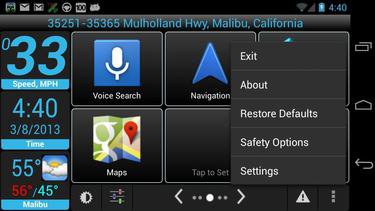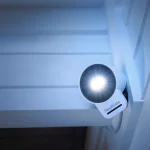Cecilia Abadie was pulled over for speeding in October. She was ticketed by the California Highway trol for that, as well as for wearing Glass while driving.
Abadie decided to challenge the ticket she had her day in traffic court recently.
This is kind of a big deal, because California’s distracted driving statute is a “primary law”; an officer can pull you over specifically because he or she saw you operating a phone while driving. So without the addition of some sort of flesh-colored shroud, anyone driving while wearing Glass does so at a greater risk of being pulled over, whether they’re operating the device or not.
The broader situation brings up the question: Is a Glass wearer at a greater risk of causing an accident? And should a distracted-driving law prohibit someone from wearing Glass in the car no matter how—or even if—they’re operating the device?
Distracted Glassing, at a glance
I’ve been a Glass Explorer since the summer driving while Glassed was one of the first things I wanted to try. I came away from the experience with mixed impressions. I’ve gone to great lengths to ensure that I can use my phone in my car safely. I have a dashboard dock to the left of the steering wheel that mounts the phone’s screen at the same eye height as my side view mirror. I’m never fumbling around for the device, a glance at the screen to check the remaining distance to the next turn is as incidental as checking my blind spots.
It’s a popular misconception that a Glass user is looking through a display into the real world. en you wake Glass (either by tapping the sidepiece or briefly tilting your head back) a business card-sized display lights up hovers just above your right eye’s field of view. You need to glance up slightly to read it.
And that’s why I ultimately stopped wearing Glass in the car. My eyes flick to my docked phone as though it were just another piece of instrumentation on the dashboard; my eyes would have been going there anyway. Glancing up isn’t something that a driver would ever naturally do, unless the police pursuit for your Distracted Driving incident suddenly involved a chase helicopter.
Glass can also light up on its own to deliver alerts warnings (such as an upcoming exit). This is a marvelous feature when the navigation app is helping me to walk through an unfamiliar city, but when I’m driving at night this thing suddenly lights up, it snaps away my full attention immediately.
So I don’t use my Glass in the car. But is Glass inherently unsafe to use?
I don’t reckon so. Glass is the least distracting computer I own. The whole point of Glass is to give you access to digital services (navigation, communication, information) while allowing you to remain immersed in the real world.
Distraction is a feature problem, not a device problem


The Car Home app simplifies Android while driving.
at Glass needs is a “car mode” akin to the one built into Android. As soon as I dock my Android phone in my car it connects to my audio system, the home screen that’s normally populated with dozens of tiny icons, fussy widgets, a wallpaper image of a hopeful squirrel is replaced by a 2×3 grid of fat buttons. The only apps I can launch from Car Home Ultra are the seven or eight navigation music apps I’ve put there, plus a button for voice comms. I don’t look at texts or emails or Tweets while I’m behind the wheel, not even when I’m at a stop light; it’s an idiotic thing to do besides, Car Home makes it way too difficult.
The buttons are so big that I can see tap them without even taking my eyes off the road. Some Android phones never even require a tap at all; they’re always listening for a trigger phrase that causes the device to await a voice comm of any complexity.
This stuff wasn’t a part of Android in the beginning. recognized that an Android phone needs to be a different kind of device when it’s inside a car, third-party apps then moved in to take advantage of those features.
Result: my Android phone is the exact opposite of distracting me when I’m driving. I insist that my phone is a safety feature. It gives me information that helps me to be a safer driver (through podcasts audiobooks) it engages the parts of my brain that get bored on long drives. Thanks to Android’s Car Mode, my phone can do all of those things without interfering with the senses braincode modules that I require for safe driving.
Glass is still firmly in its experimental phase. One day, it could become a further refinement of Car Mode.
at if, instead of lighting up the screen to present fine-grained information, Glass only delivered a simple signal through my peripheral vision? I trust the traffic warnings that I get through ze. If my Glass glowed up a symbol that indicated “Slow down,” I’d probably tap the brakes first ask questions (in the form of looking at my phone screen) later.
gislating the legend, not the device
Computers in cars are ubiquitous now, but back when I installed my first car dock, my old beater car instantly had better instrumentation in-car entertainment than a new $60,000 Audi. I found that I needed to explain the concept to almost everybody. They couldn’t imagine that operating what amounted to a personal computer while driving could result in anything less than a snaky set of skid marks leading to a thick, tall scorch mark on a highway bridge abutment.
re these people ignorant? Naw. ll, yes, of course, but only through the sterile definition of the term not the judgmental one. This was all new territory for them. It wasn’t a hassle for me to explain how this gear enhanced my safety the safety of everyone else driving near me; it was a responsibility.
Ditto when “texting while driving” became an election-year goldmine for marginal cidates. As early adopters, it was our responsibility to make sure that distracted-driving laws were scalpels that prohibited unsafe activity instead of broadswords that required me to drop my phone in a copper-mesh bag lock it inside my glovebox before I turned the key.
And so it goes with Glass. thout the benefit of first-h experience, people are apt to fill in the blanks on their own.
By far, the most frequent question when people stop to ask me about my Glass is “Are you taking my picture right now?” It’s asked in a good-natured way, but it encourages me to explain that taking photos video with this thing is a very explicit action, that its storage, battery, concealment limitations make Glass a terrible device for covert photography. If you need to take shots of innocent, unaware strangers for your incredibly creative innovative “ople I Saw On The Subway om I’d ke To Mock From The Safety And Anonymity Of Tumblr” blog, you’d want to do it through the headset buttons plugged into your phone… not Glass.
In a moment, the results of that trial
Ms. Abadie’s “driving while wearing Glass” ticket was invalidated by the traffic court commissioner. In truth, she wasn’t ticketed for distracted driving. The officer cited her for violating Section 27602 of the California vehicle code, which broadly prohibits the use of TV screens in cars. The judge ruled that the officer couldn’t prove that Glass’ screen was actually lit up when Abadie was pulled over.
ich further illustrates the problem of new, wearable technology in a world of old clumsy legislation. Is Glass a hsfree device—seen by law enforcement advocacy groups as a partial solution to the problem of distracted driving—or is it a video screen?
Three states (New rsey, Delaware, st Virginia) have preemptively banned Glass other wearable computers with head-mounted displays from the roads. wmakers’ intentions are good, but I’m confident that in the near future we’ll see a generation of devices that will require those laws to be revisited, if not outright repealed. None of us want to share a road with someone wearing an Oculus Rift…but what about a soft, pinpoint red light in the corner of your eyeglasses that glows when your car computer or darkened phone needs to tell you something genuinely important? at about a future display technology that enhances our vision comprehension through augmented reality, without interfering with our natural senses?
e will solve these problems. Either Glass devices like it are a fad that will soon fade (thus rendering these questions irrelevant), or makers will create new devices that are so sophisticated relevant to the average consumer that widespread experience will overtake widespread ignorance.
Until then, early adopters like me should take advantage of the ignorance. en I was in college, I was able to talk my way out of what would have been my first speeding ticket ever. The officer’s attention was distracted by the presence of the 2-bit D screen that I’d Velcroed to the dash of my ntiac. After I spent ten minutes giving him his first real world experience with the Global sitioning System about five minutes of Q&A about how it worked, he’d kind of gotten over being angry with me for doing 45 in a 30 mile-per-hour zone.


















